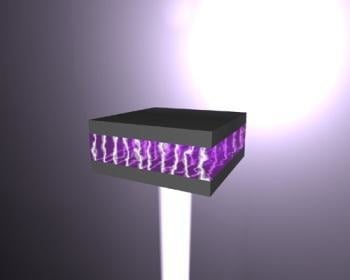A Review of Ultrahigh Efficiency III-V Semiconductor Compound Solar Cells: Multijunction Tandem, Lower Dimensional, Photonic Up/Down Conversion and Plasmonic Nanometallic Structures
Abstract
:1. Introduction

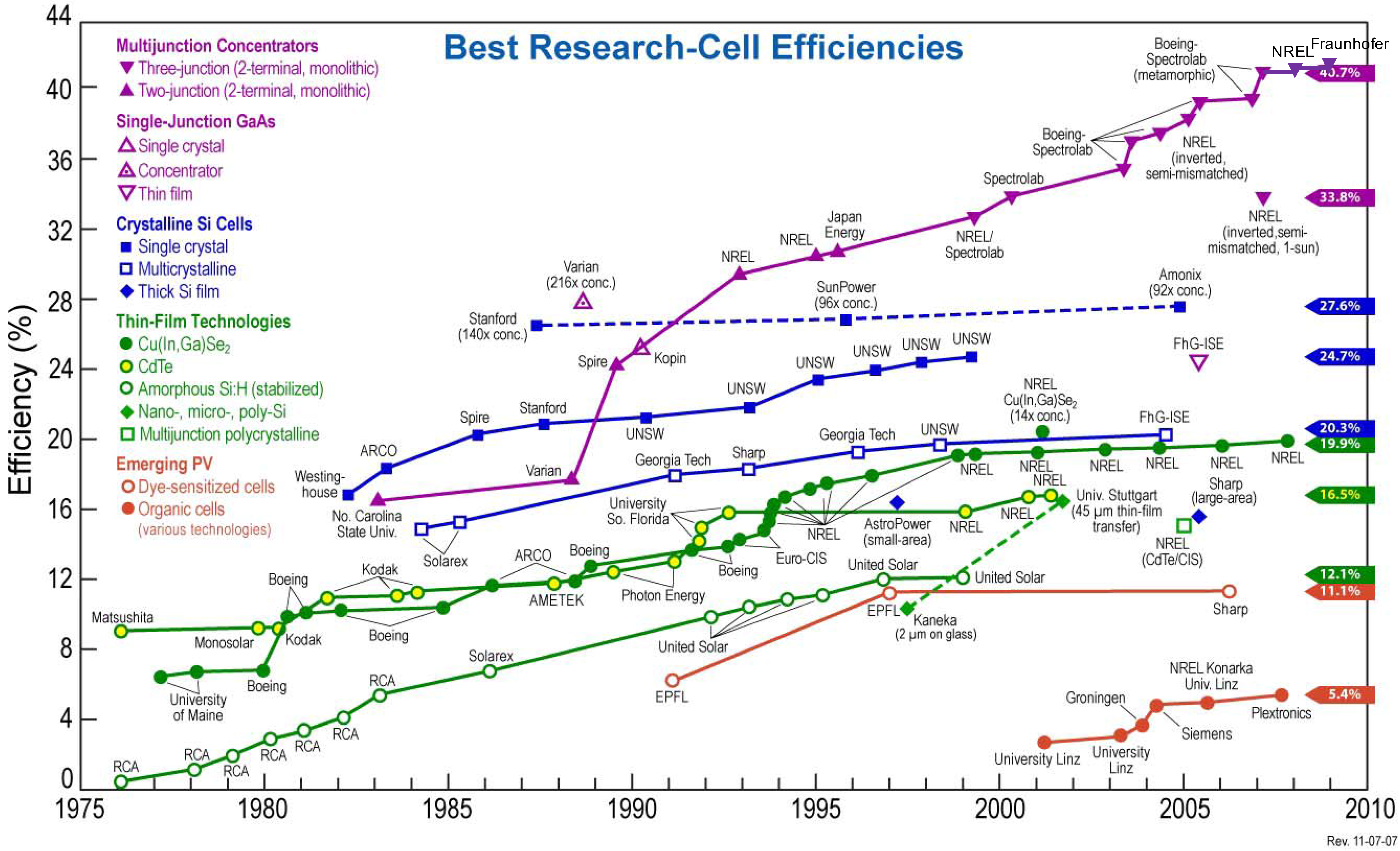
2. Developments of Multijunction III-V Solar Cells
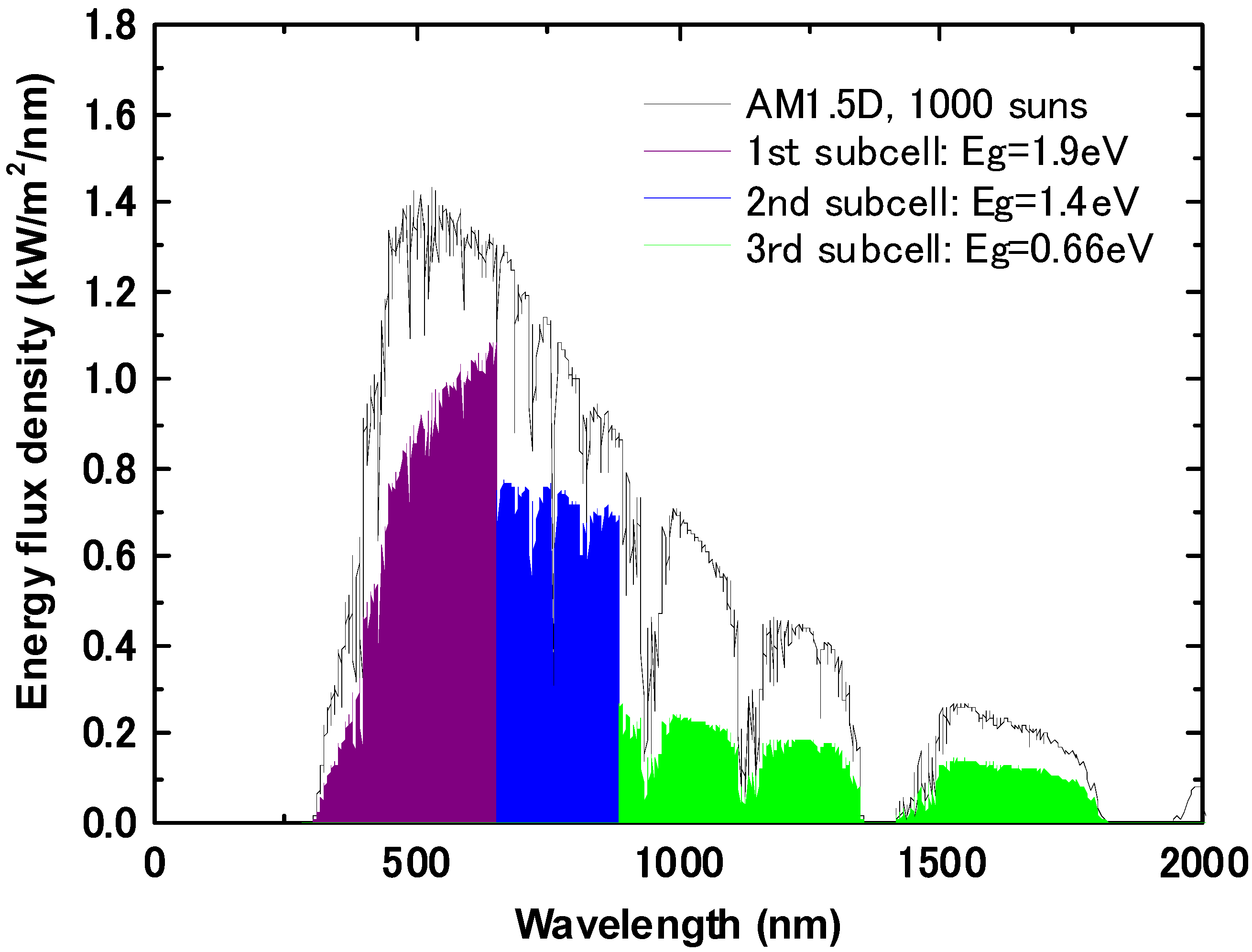
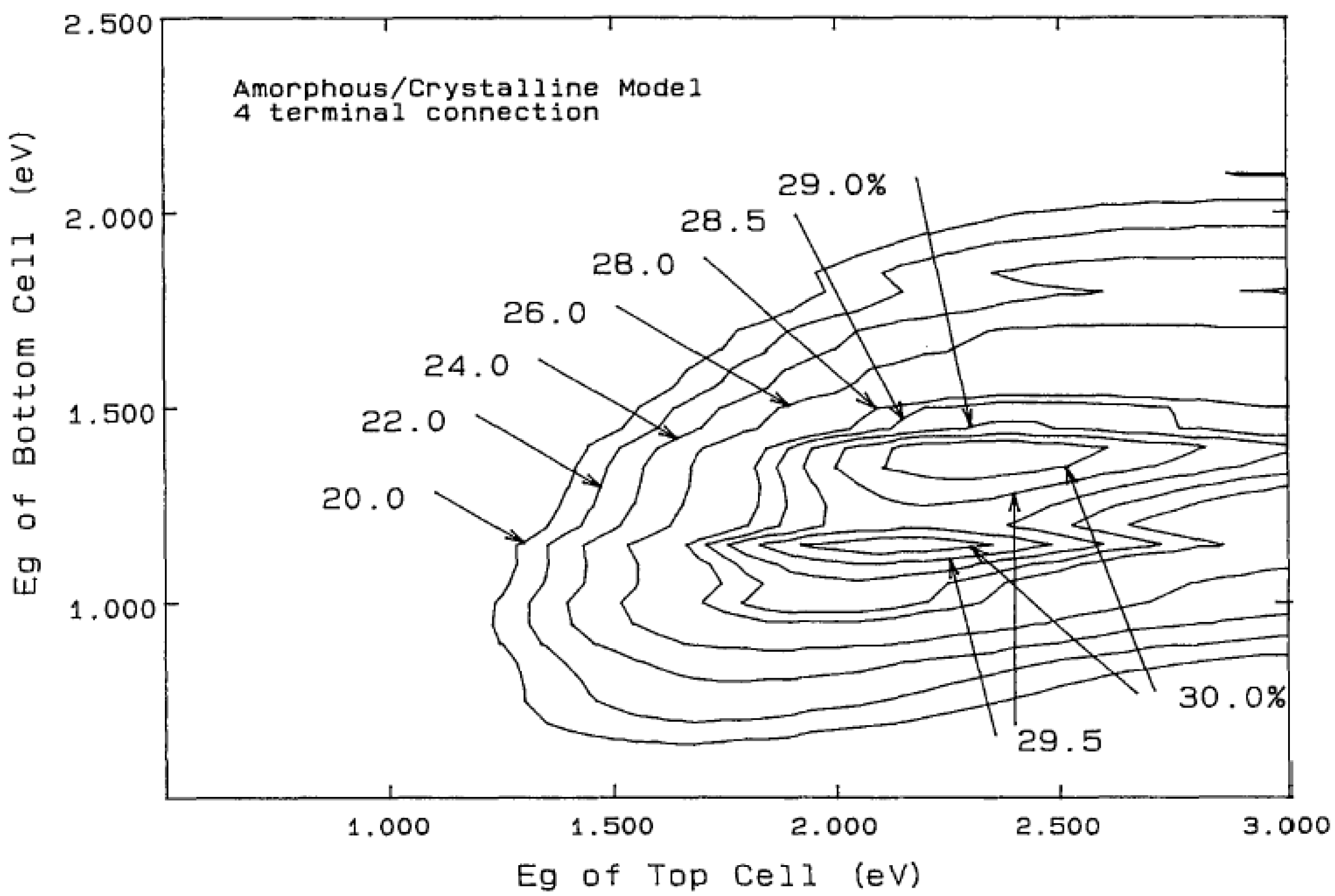
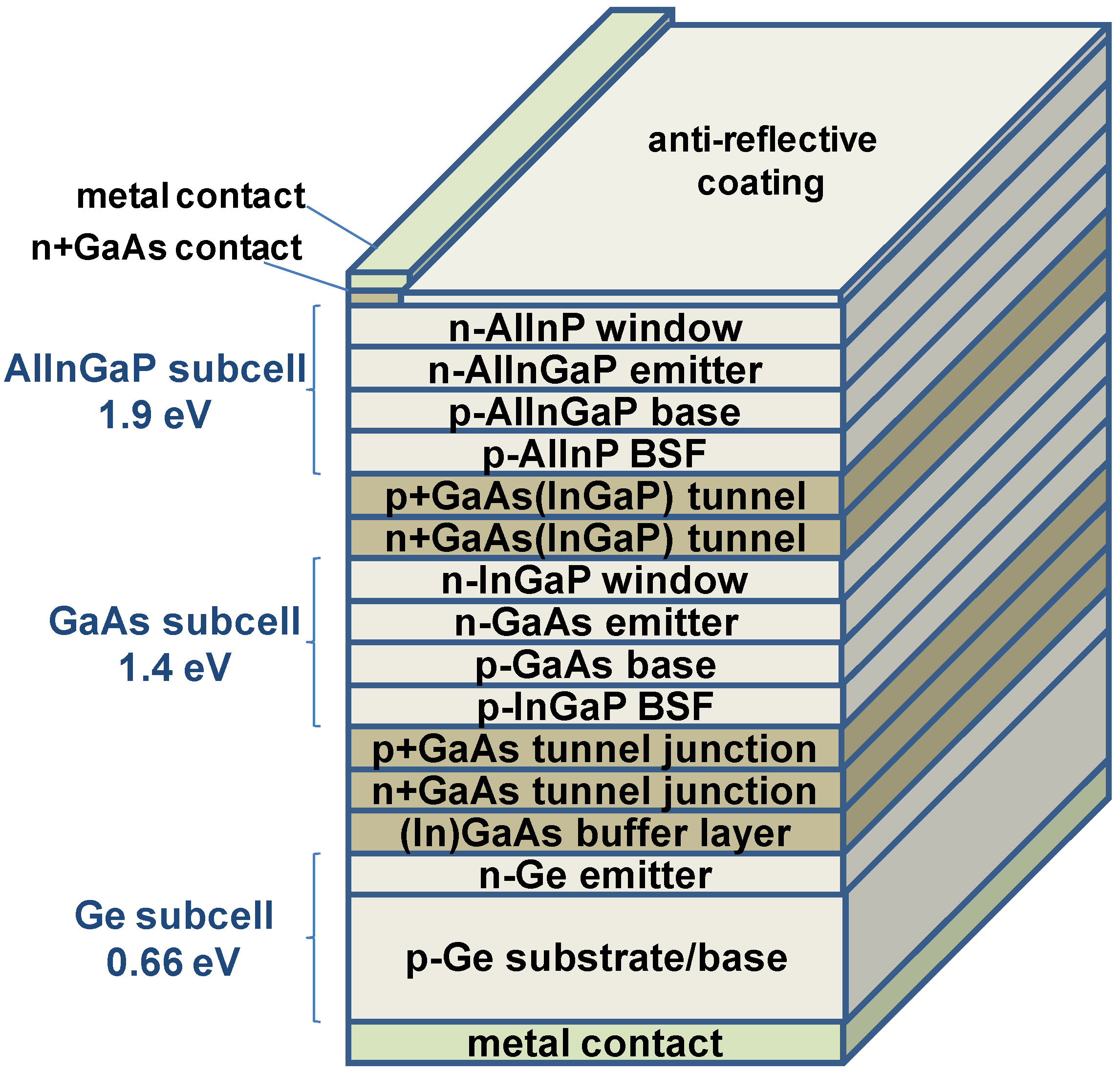
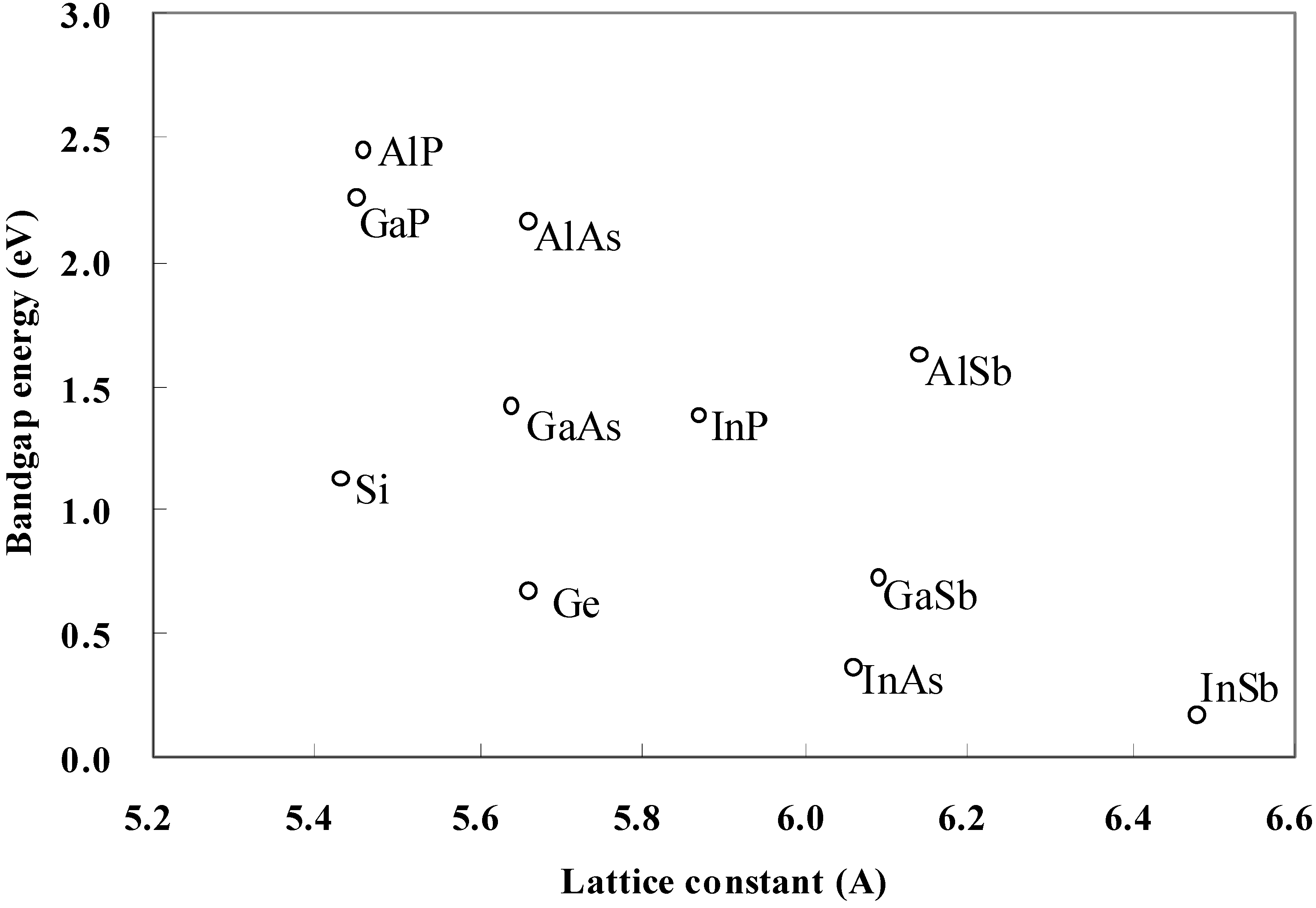
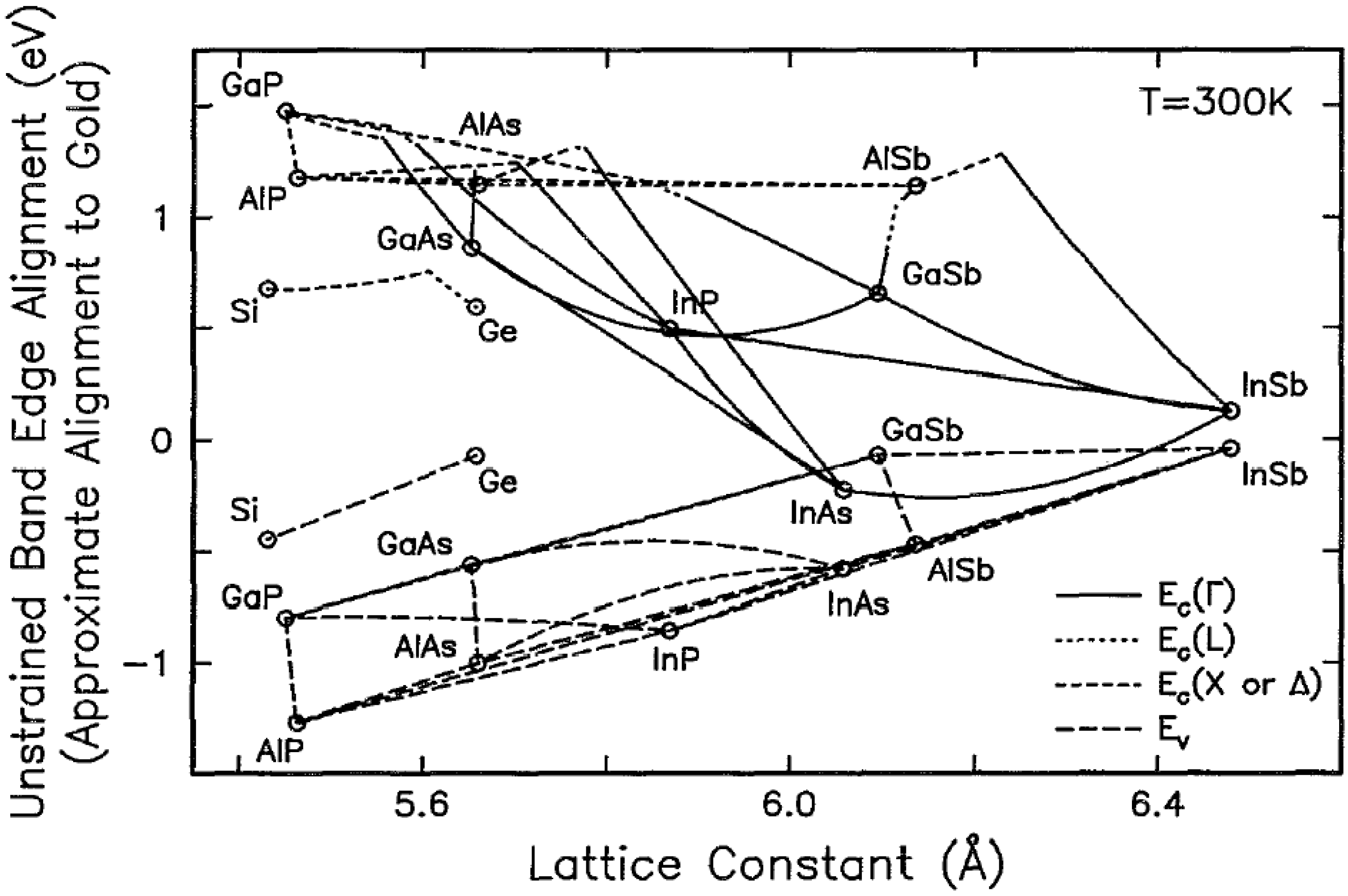
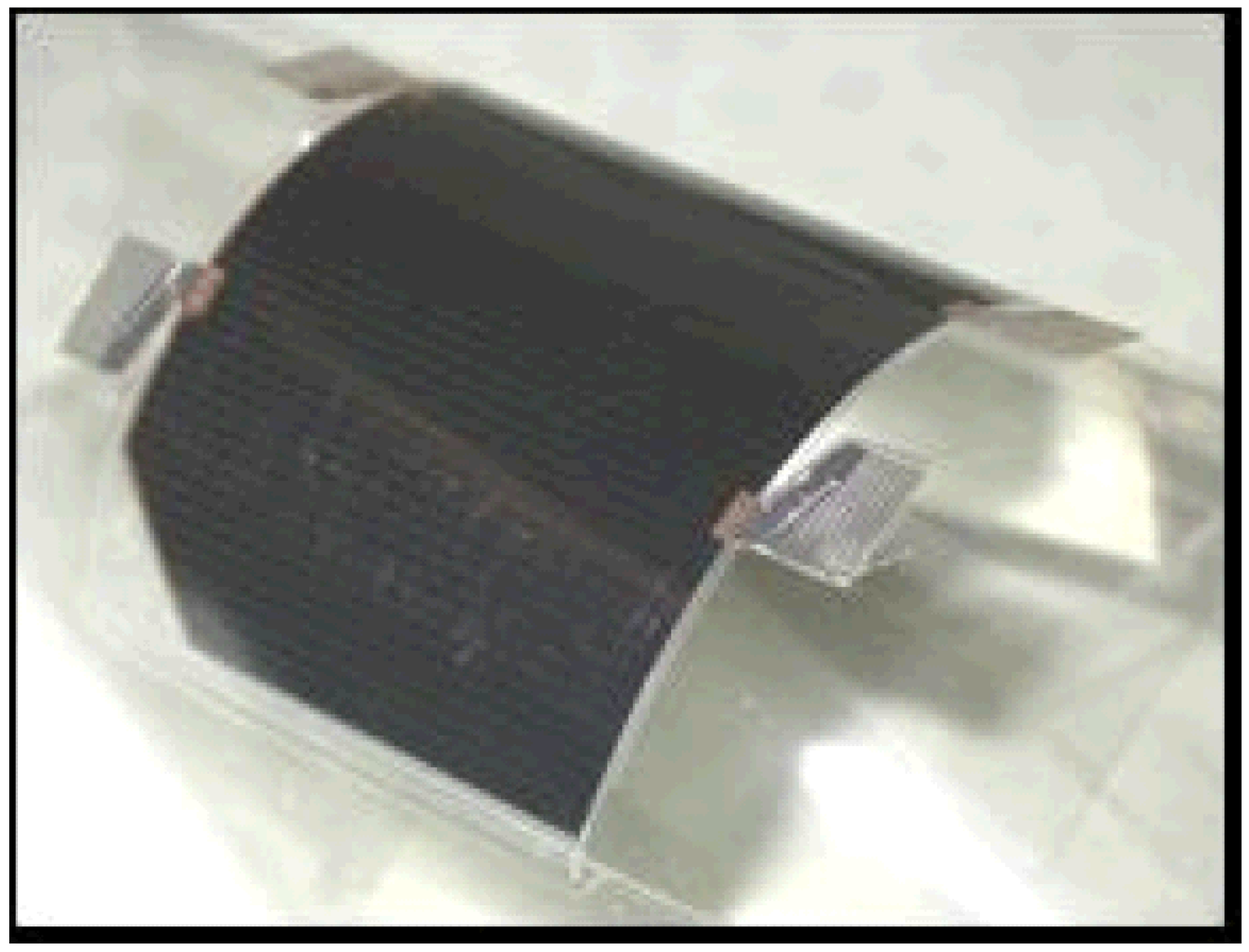
3. 1.0 eV Bandgap Subcells
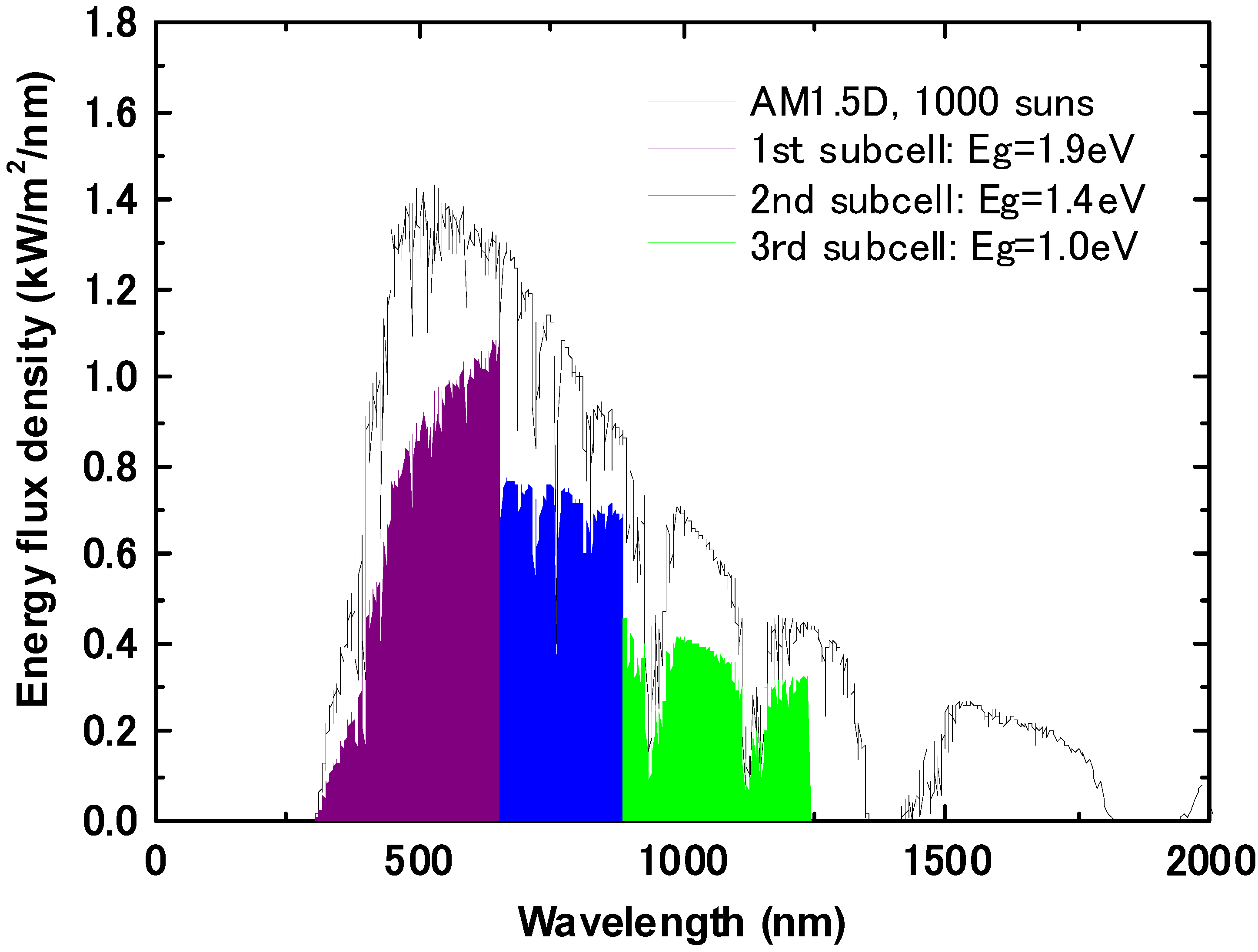
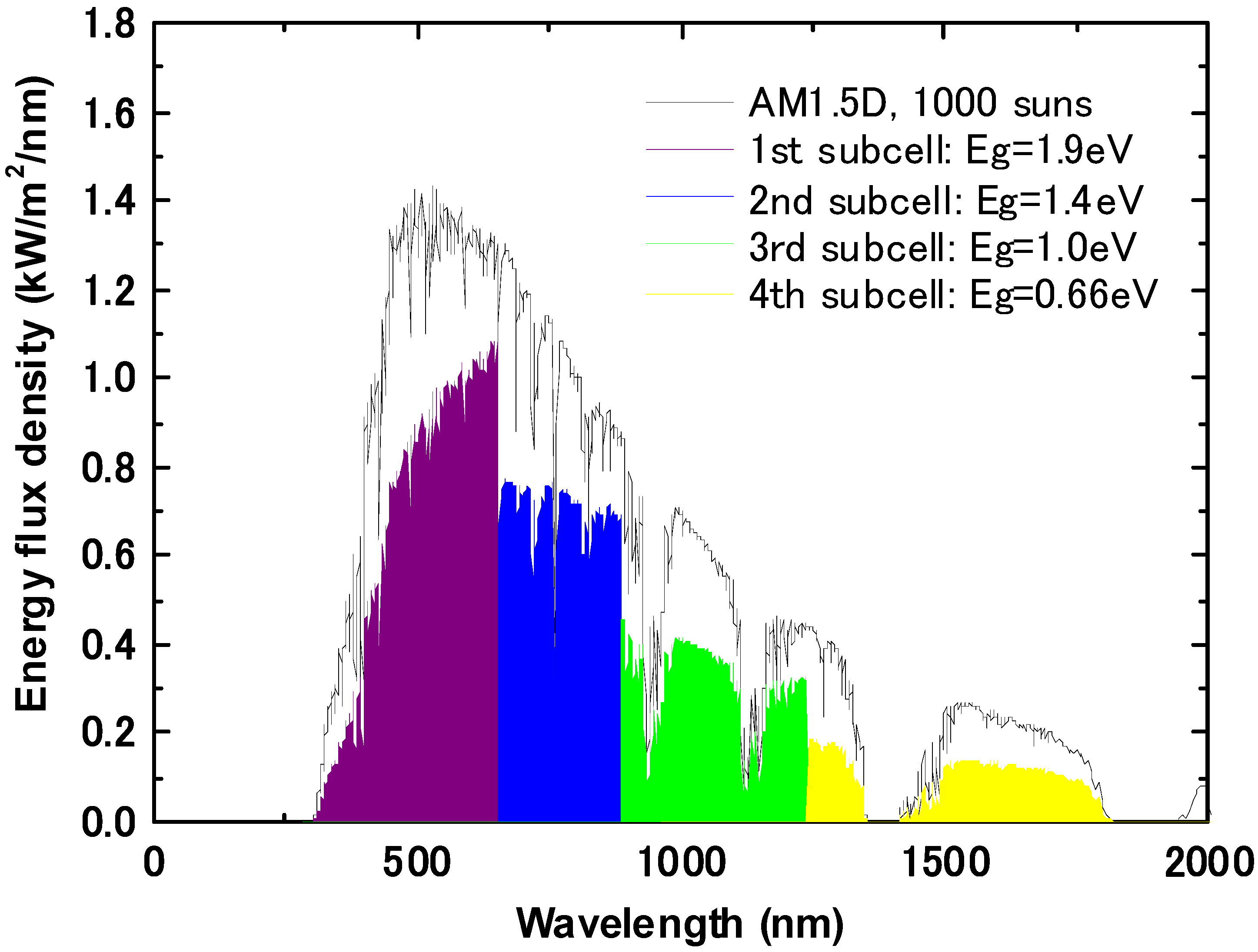
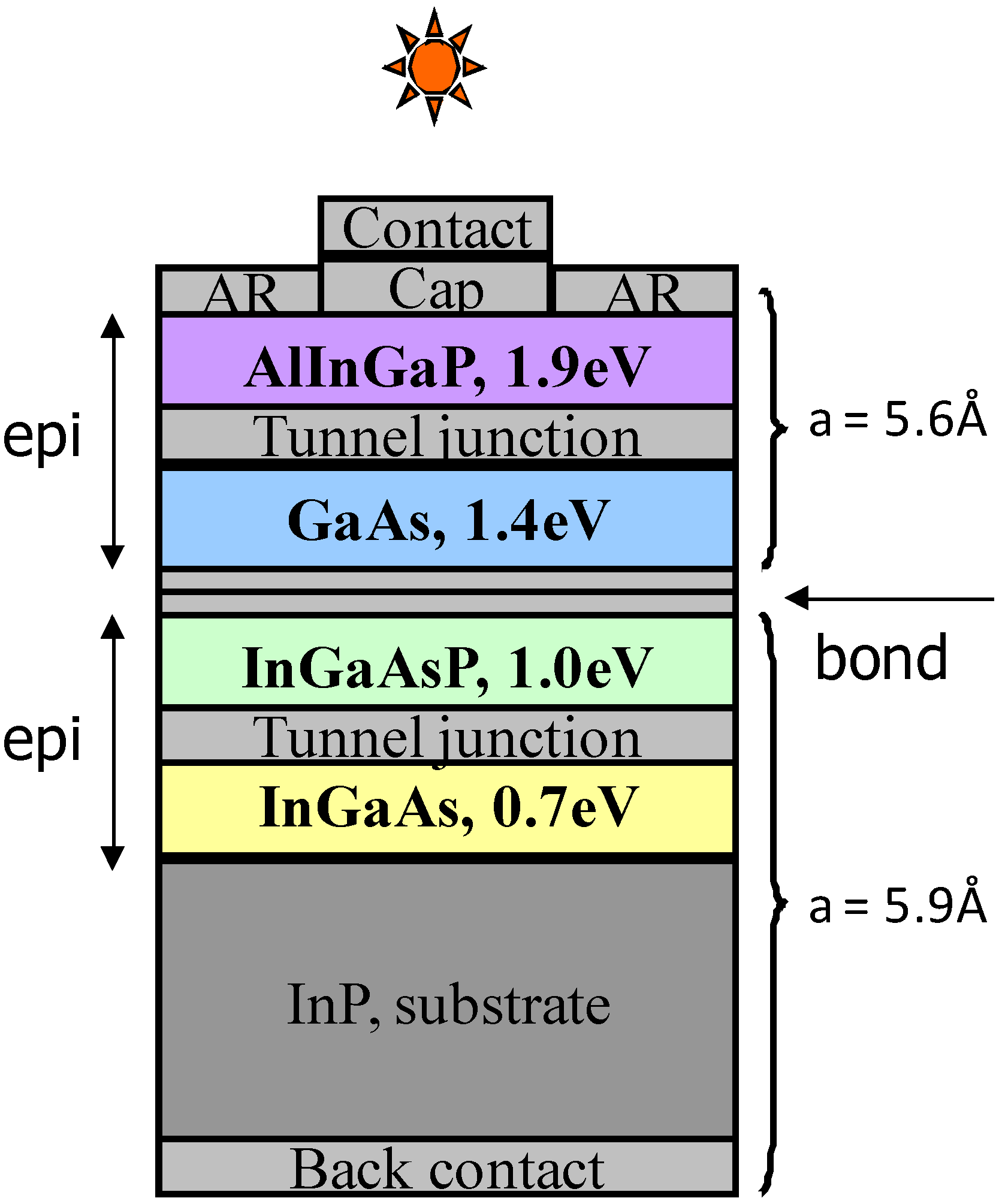
4. Utilization of Higher Energy Photons
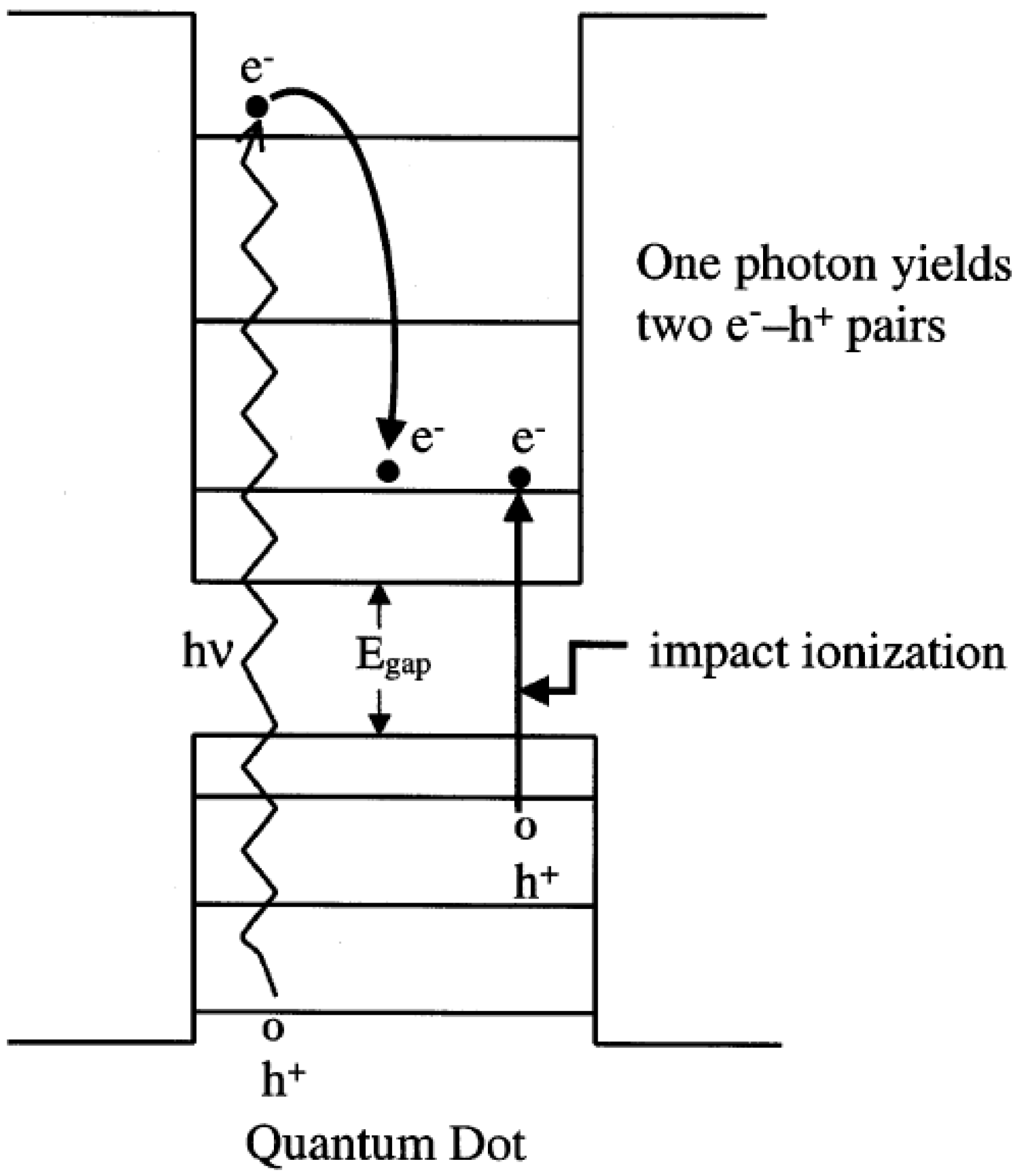
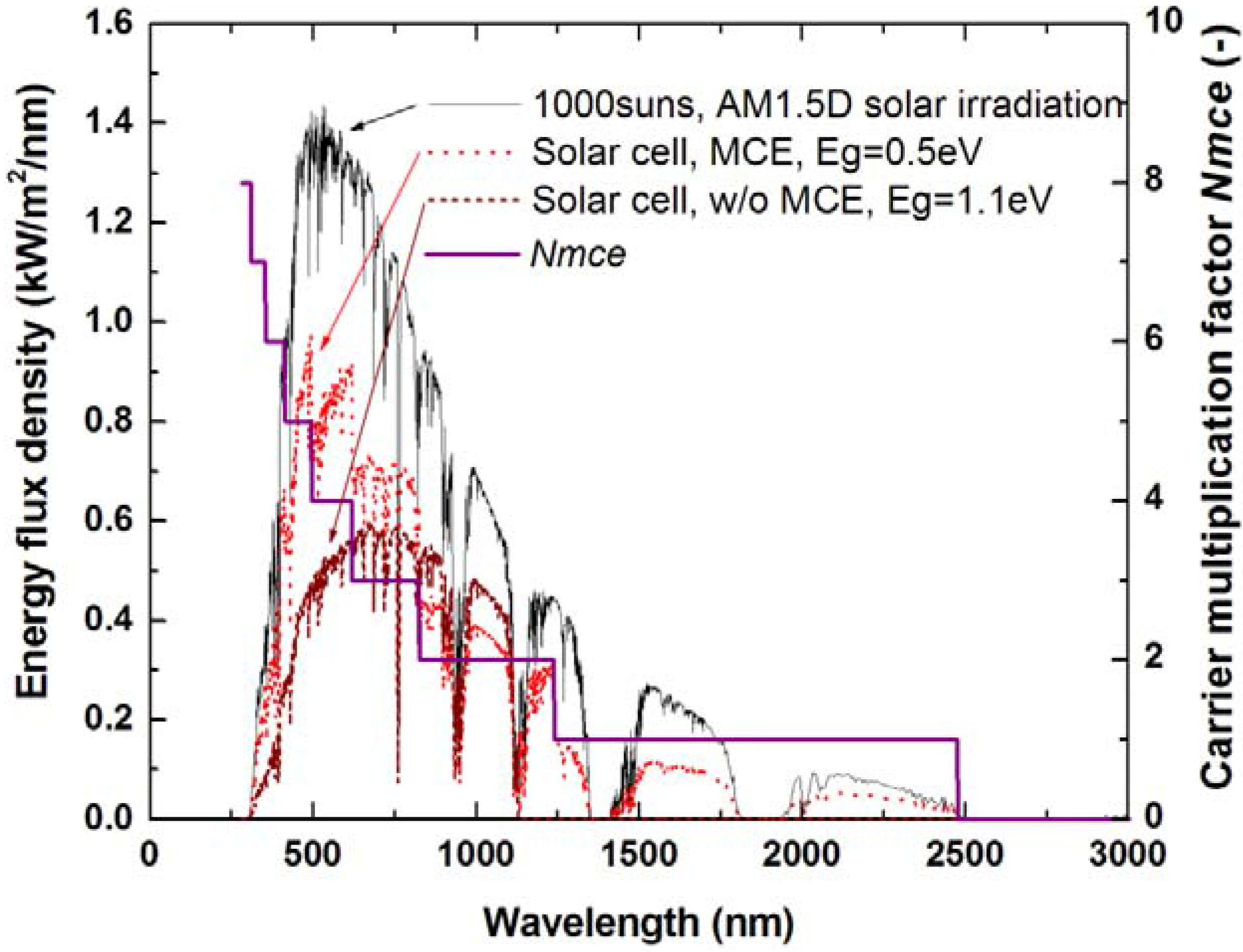
5. Utilization of Lower Energy Photons
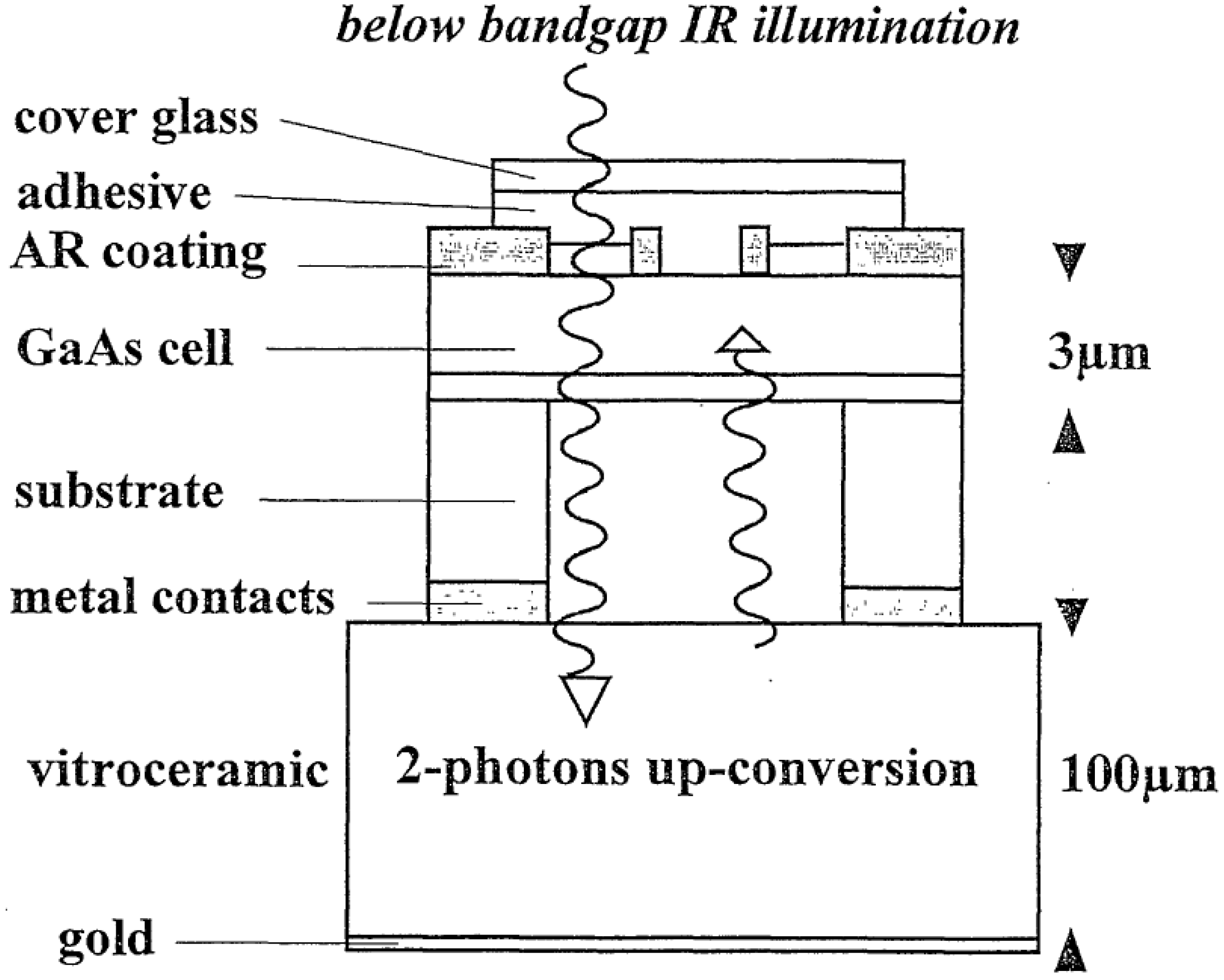

6. Plasmonic Nanometallic Structures for Light Absorption Enhancement
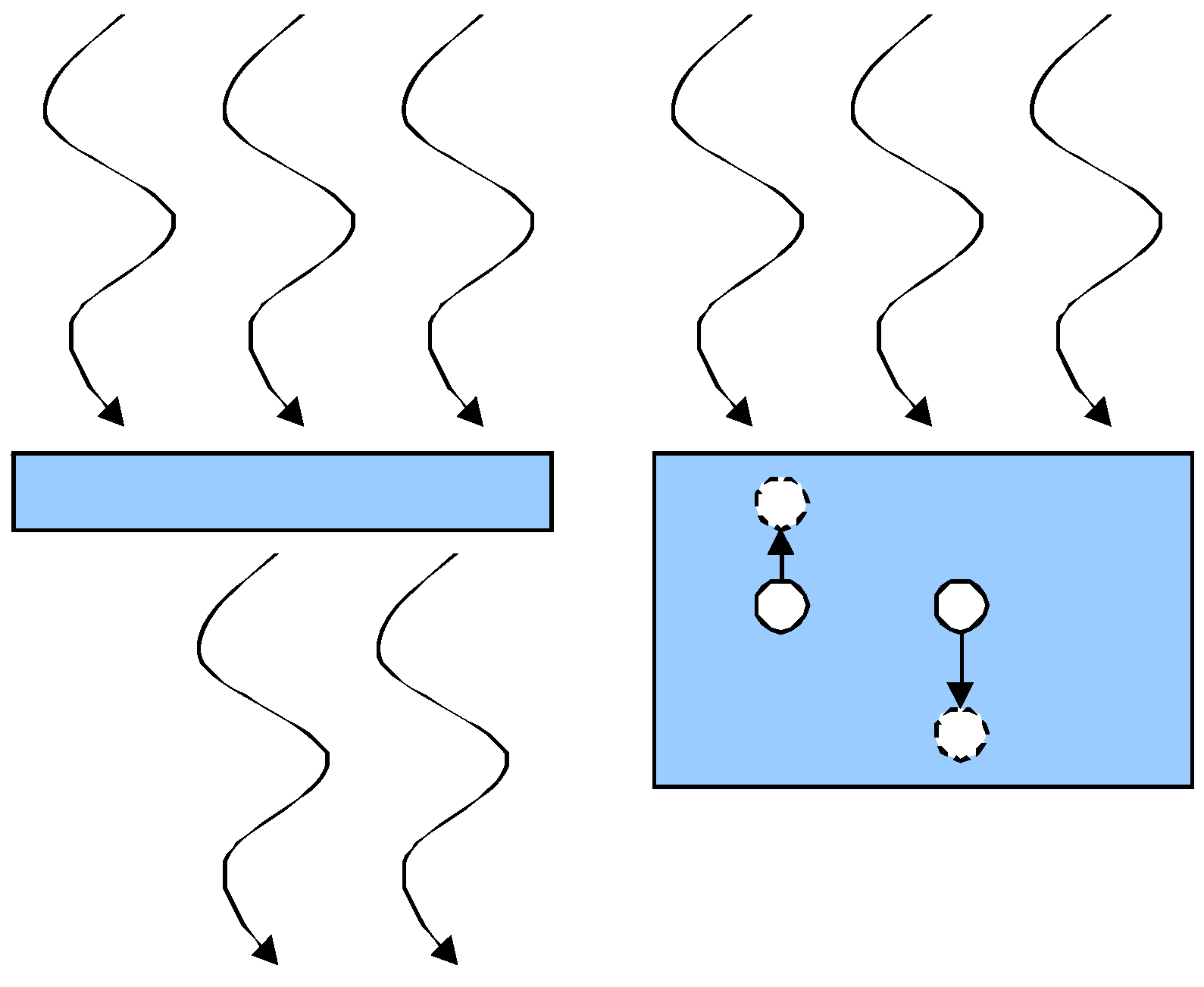

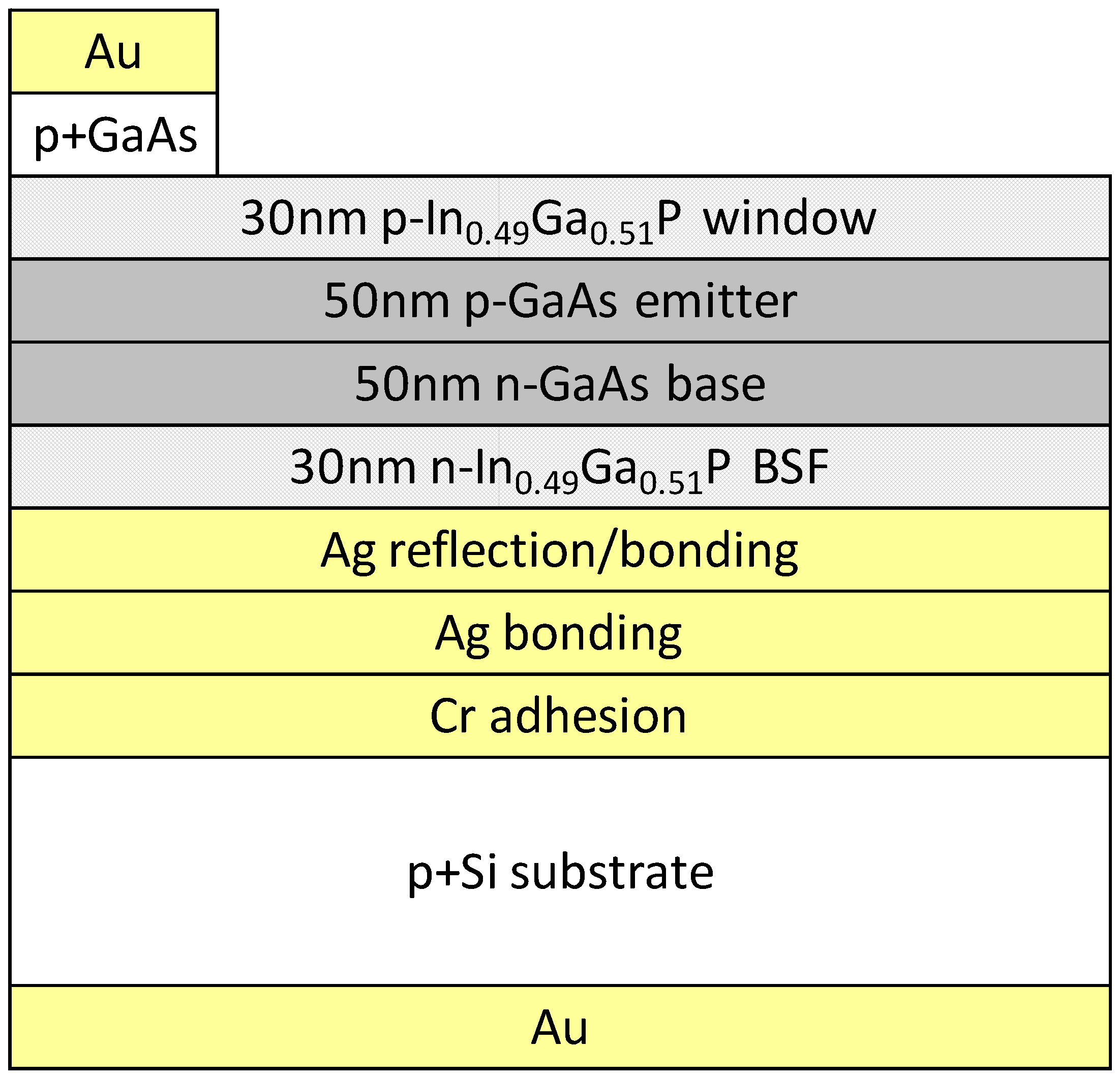
7. Conclusions
References and Notes
- Nozik, A.J. Exciton multiplication and relaxation dynamics in quantum dots: Applications to ultrahigh-efficiency solar photon conversion. Inorg. Chem. 2005, 44, 6893–6899. [Google Scholar] [CrossRef] [PubMed]
- Emery, K.A.; Osterwald, C.R. Solar-cell efficiency measurements. Sol. Cells 1986, 17, 253–274. [Google Scholar] [CrossRef]
- Nann, S.; Emery, K. Spectral effects on PV-device rating. Sol. Energy Mater. Sol. Cells 1992, 27, 189–216. [Google Scholar] [CrossRef]
- Emery, K. Measurement and characterization of solar cells and modules. In Handbook of Photovoltaic Science and Engineering, 1st ed.; Luque, A., Hegedus, S., Eds.; Wiley: New York, NY, USA, 2003; Chapter 16; pp. 701–752. [Google Scholar]
- Shockley, W.; Queisser, H.J. Detailed balance limit of efficiency of p-n junction solar cells. J. Appl. Phys. 1961, 32, 510–519. [Google Scholar] [CrossRef]
- Campbell, P.; Green, M.A. The limiting efficiency of silicon solar-cells under concentrated sunlight. IEEE Trans. Electron Devices 1986, 33, 234–239. [Google Scholar] [CrossRef]
- Andreev, V.M.; Grilikhes, V.A.; Rumyantev, V.D. Photovoltaic Conversion of Concentrated Sunlight, 1st ed.; Wiley: New York, NY, USA, 1997. [Google Scholar]
- Swanson, R.M. Photovoltaic Concentrators. In Handbook of Photovoltaic Science and Engineering, 1st ed.; Luque, A., Hegedus, S., Eds.; Wiley: New York, NY, USA, 2003; Chapter 11; pp. 449–503. [Google Scholar]
- Green, M.A.; Emery, K.; Hishikawa, Y.; Warta, W. Solar cell efficiency tables (version 33). Prog. Photovoltaics Res. Appl. 2009, 17, 85–94. [Google Scholar] [CrossRef]
- Kazmerski, L.L.; Gwinner, D.; Hicks, A. Best research-cell efficiencies. Available online: http://en.wikipedia.org/wiki/File:PVeff(rev110707)d.png (accessed July 9, 2009).
- Henry, C.H. Limiting efficiencies of ideal single and multiple energy-gap terrestrial solar-cells. J. Appl. Phys. 1980, 51, 4494–4500. [Google Scholar] [CrossRef]
- Takakura, H. Optimum design of thin-film-based tandem-type solar-cells. Jpn. J. Appl. Phys. 1992, 31, 2394–2399. [Google Scholar] [CrossRef]
- Kurtz, S.R.; Faine, P.; Olson, J.M. Modeling of 2-junction, series-connected tandem solar-cells using top-cell thickness as an adjustable-parameter. J. Appl. Phys. 1990, 68, 1890–1895. [Google Scholar] [CrossRef]
- Bett, A.W.; Dimroth, F.; Stollwerck, G.; Sulima, O.V. III-V compounds for solar cell applications. Appl. Phys. A 1999, 69, 119–129. [Google Scholar] [CrossRef]
- Olson, J.M.; Friedman, D.J.; Kurtz, S. High-efficiency III-V multijunction solar cells. In Handbook of Photovoltaic Science and Engineering, 1st ed.; Luque, A., Hegedus, S., Eds.; Wiley: New York, NY, USA, 2003; Chapter 9; pp. 359–411. [Google Scholar]
- Sugo, M.; Takanashi, Y.; Aljassim, M.M.; Yamaguchi, M. Heteroepitaxial growth and characterization of InP on Si substrates. J. Appl. Phys. 1990, 68, 540–547. [Google Scholar] [CrossRef]
- Dupuis, R.D. III-V semiconductor heterojunction devices grown by metalorganic chemical vapor deposition. IEEE J. Sel. Top. Quantum Electron. 2000, 6, 1040–1050. [Google Scholar] [CrossRef]
- Shimizu, Y.; Okada, Y. Growth of high-quality GaAs/Si films for use in solar cell applications. J. Cryst. Growth 2004, 265, 99–106. [Google Scholar] [CrossRef]
- Li, Y.; Weatherlyy, G.C.; Niewczas, M. TEM studies of stress relaxation in GaAsN and GaP thin films. Phil. Mag. 2005, 85, 3073–3090. [Google Scholar] [CrossRef]
- Tiwari, S.; Frank, D.J. Empirical fit to band discontinuities and barrier heights in III-V alloy systems. Appl. Phys. Lett. 1992, 60, 630–632. [Google Scholar] [CrossRef]
- Olson, J.M.; Kurtz, S.R.; Kibbler, A.E.; Faine, P. A 27.3-percent efficient Ga0.5In0.5P/GaAs tandem solar-cell. Appl. Phys. Lett. 1990, 56, 623–625. [Google Scholar] [CrossRef]
- Bertness, K.A.; Kurtz, S.R.; Friedman, D.J.; Kibbler, A.E.; Kramer, C.; Olson, J.M. 29.5-percent-efficient GaInP/GaAs tandem solar-cells. Appl. Phys. Lett. 1994, 65, 989–991. [Google Scholar] [CrossRef]
- Takamoto, T.; Ikeda, E.; Kurita, H.; Ohmori, M. Over 30% efficient InGaP/GaAs tandem solar cells. Appl. Phys. Lett. 1997, 70, 381–383. [Google Scholar] [CrossRef]
- Fraas, L.M.; Avery, J.E.; Sundaram, V.S.; Kinh, V.T.; Davenport, T.M.; Yerkes, J.W.; Gee, J.M.; Emery, K.A. Over 35% efficient GaAs/GaSb stacked concentrator cell assemblies for terrestrial applications. In Proceedings of the 21st IEEE Photovoltaic Specialists Conference, Kissimimee, FL, USA, May 1990; pp. 190–195.
- Garcia, I.; Rey-Stolle, I.; Galiana, B.; Algora, C. A 32.6% efficient lattice-matched dual-junction solar cell working at 1000 suns. Appl. Phys. Lett. 2009, 94, 053509. [Google Scholar] [CrossRef]
- King, R.R.; Law, D.C.; Fetzer, C.M.; Sherif, R.A.; Edmondson, K.M.; Kurtz, S.; Kinsey, G.S.; Cotal, H.L.; Krut, D.D.; Ermer, J.H.; Karam, N.H. Pathway to 40% efficient concentrator photovoltaics. In Proceedings of the 20th European Photovoltaic Solar Energy Conference, Barcelona, Spain, June 2005; pp. 118–123.
- King, R.R.; Law, D.C.; Edmondson, K.M.; Fetzer, C.M.; Sherif, R.A.; Kinsey, G.S.; Krut, D.D.; Cotal, H.L.; Karam, N.H. Metamorphic and lattice-matched solar cells under concentration. In Proceedings of the IEEE 4th World Conference on Photovoltaic Energy Conversion, Waikoloa, HI, USA, May 2006; pp. 760–763.
- King, R.R.; Law, D.C.; Edmondson, K.M.; Fetzer, C.M.; Kinsey, G.S.; Krut, D.D.; Ermer, J.H.; Sherif, R.A.; Karam, N.H. Metamorphic concentrator solar cells with over 40% conversion efficiency. In Proceedings of the 4th International Conference on Solar Concentrators, El Escorial, Spain, March 2007; pp. 5–8.
- King, R.R.; Law, D.C.; Edmondson, K.M.; Fetzer, C.M.; Kinsey, G.S.; Yoon, H.; Sherif, R.A.; Karam, N.H. 40% efficient metamorphic GaInP/GaInAs/Ge multijunction solar cells. Appl. Phys. Lett. 2007, 90, 183516. [Google Scholar] [CrossRef]
- Guter, W.; Schone, J.; Philipps, S.P.; Steiner, M.; Siefer, G.; Wekkeli, A.; Welser, E.; Oliva, E.; Bett, A.W.; Dimroth, F. Current-matched triple-junction solar cell reaching 41.1% conversion efficiency under concentrated sunlight. Appl. Phys. Lett. 2009, 94, 223504. [Google Scholar] [CrossRef]
- Takamoto, T.; Agui, T.; Washio, H.; Takahashi, N.; Nakamura, K.; Anzawa, O.; Kaneiwa, M.; Kamimura, K.; Okamoto, K.; Yamaguchi, M. Future development of InGaP/(In)GaAs based multijunction solar cells. In Proceedings of the 31st IEEE Photovoltaic Specialists Conference, Lake Buena Vista, FL, USA, January 2005; pp. 519–524.
- Law, D.C.; Edmondson, K.M.; Siddiqi, N.; Paredes, A.; King, R.R.; Glenn, G.; Labios, E.; Haddad, M.H.; Isshiki, T.D.; Karam, N.H. Lightweight, flexible, high-efficiency III-V multijunction solar cells. In Proceedings of the IEEE 4th World Conference on Photovoltaic Energy Conversion, Waikoloa, HI, USA, May 2006; pp. 1879–1882.
- Takamoto, T.; Kodama, T.; Yamaguchi, H.; Agui, T.; Takahashi, N.; Washio, H.; Hisamatsu, T.; Kaneiwa, M.; Okamoto, K.; Imaizumi, M.; Kibe, K. Paper-thin InGaP/GaAs solar cells. In Proceedings of the IEEE 4th World Conference on Photovoltaic Energy Conversion, Waikoloa, HI, USA, May 2006; pp. 1769–1772.
- Karam, N.H.; King, R.R.; Haddad, M.; Ermer, J.H.; Yoon, H.; Cotal, H.L.; Sudharsanan, R.; Eldredge, J.W.; Edmondson, K.; Joslin, D.E.; Krut, D.D.; Takahashi, M.; Nishikawa, W.; Gillanders, M.; Granata, J.; Hebert, P.; Cavicchi, B.T.; Lillington, D.R. Recent developments in high-efficiency Ga0.5In0.5P/GaAs/Ge dual- and triple-junction solar cells: steps to next-generation PV cells. Sol. Energy Mater. Sol. Cells 2001, 66, 453–466. [Google Scholar] [CrossRef]
- King, R.R.; Fetzer, C.M.; Law, D.C.; Edmondson, K.M.; Yoon, H.; Kinsey, G.S.; Krut, D.D.; Ermer, J.H.; Hebert, P.; Cavicchi, B.T.; Karam, N.H. Advanced III-V multijunction cells for space. In Proceedings of the IEEE 4th World Conference on Photovoltaic Energy Conversion 2006, Waikoloa, HI, USA, May 2006; pp. 1757–1762.
- Myers, D.R.; Kurtz, S.R.; Emery, K.; Whitaker, C.; Townsend, T. Outdoor meteorological broadband and spectral conditions for evaluating photovoltaic modules. In Proceedings of the 28th IEEE Photovoltaic Specialists Conference, Anchorage, AK, USA, September 2000; pp. 1202–1205.
- Hamzaoui, H.; Bouazzi, A.S.; Rezig, B. Theoretical possibilities of InxGa1-xN tandem PV structures. Sol. Energy Mater. Sol. Cells 2005, 87, 595–603. [Google Scholar] [CrossRef]
- Jani, O.; Honsberg, C.; Yong, H.; Song, J.O.; Ferguson, I.; Namkoong, G.; Trybus, E.; Doolittle, A.; Kurtz, S. Design, growth, fabrication and characterization of high-band gap InGaN/GaN solar cells. In Proceedings of the IEEE 4th World Conference on Photovoltaic Energy Conversion, Waikoloa, HI, USA, May 2006; pp. 20–25.
- Jani, O.; Ferguson, I.; Honsberg, C.; Kurtz, S. Design and characterization of GaN/InGaN solar cells. Appl. Phys. Lett. 2007, 91, 132117. [Google Scholar] [CrossRef]
- Yang, C.B.; Wang, X.L.; Xiao, H.L.; Ran, J.X.; Wang, C.M.; Hu, G.X.; Wang, X.H.; Zhang, X.B.; Li, M.P.; Li, J.M. Photovoltaic effects in InGaN structures with p-n junctions. Phys. Status Solidi A 2007, 204, 4288–4291. [Google Scholar] [CrossRef]
- Wu, J.; Walukiewicz, W.; Yu, K.M.; Ager, J.W.; Li, S.X.; Haller, E.E.; Lu, H.; Schaff, W.J. Universal bandgap bowing in group-III nitride alloys. Solid State Commun. 2003, 127, 411–414. [Google Scholar] [CrossRef]
- Kintisch, E. Solar power: Light-splitting trick squeezes more electricity out of sun’s rays. Science 2007, 317, 583–584. [Google Scholar] [CrossRef] [PubMed]
- Barnett, A.; Kirkpatrick, D.; Honsberg, C.; Moore, D.; Wanlass, M.; Emery, K.; Schwartz, R.; Carlson, D.; Bowden, S.; Aiken, D.; Gray, A.; Kurtz, S.; Kazmerski, L.; Steiner, M.; Gray, J.; Davenport, T.; Buelow, R.; Takacs, L.; Shatz, N.; Bortz, J.; Jani, O.; Goossen, K.; Kiamilev, F.; Doolittle, A.; Ferguson, I.; Unger, B.; Schmidt, G.; Christensen, E.; Salzman, D. Very high efficiency solar cell modules. Prog. Photovoltaics Res. Appl. 2009, 17, 75–83. [Google Scholar] [CrossRef]
- Casey, H.C.; Sell, D.D.; Wecht, K.W. Concentration-dependence of absorption-coefficient for n-type and p-type GaAs between 1.3 and 1.6 eV. J. Appl. Phys. 1975, 46, 250–257. [Google Scholar] [CrossRef]
- Casey, H.C.; Stern, F. Concentration-dependent absorption and spontaneous emission of heavily doped GaAs. J. Appl. Phys. 1976, 47, 631–643. [Google Scholar] [CrossRef]
- Blakemore, J.S. Semiconducting and other major properties of gallium-arsenide. J. Appl. Phys. 1982, 53, R123–R181. [Google Scholar] [CrossRef]
- King, R.R.; Haddad, M.; Isshiki, T.; Colter, P.; Ermer, J.; Yoon, H.; Joslin, D.E.; Karam, N.H. Next-generation, high-efficiency III-V multijunction solar cells. In Proceedings of the 28th IEEE Photovoltaic Specialists Conference, Anchorage, AK, USA, September 2000; pp. 998–1001.
- Dimroth, F.; Schubert, U.; Bett, A.W. 25.5% efficient Ga0.35In0.65P/Ga0.83In0.17 as tandem solar cells grown on GaAs substrates. IEEE Electron Dev. Lett. 2000, 21, 209–211. [Google Scholar] [CrossRef]
- Kondow, M.; Uomi, K.; Niwa, A.; Kitatani, T.; Watahiki, S.; Yazawa, Y. GaInNAs: A novel material for long-wavelength-range laser diodes with excellent high-temperature performance. Jpn. J. Appl. Phys. 1996, 35, 1273–1275. [Google Scholar] [CrossRef]
- Geisz, J.F.; Friedman, D.J.; Olson, J.M.; Kurtz, S.R.; Keyes, B.M. Photocurrent of 1 eV GaInNAs lattice-matched to GaAs. J. Cryst. Growth 1998, 195, 401–408. [Google Scholar] [CrossRef]
- Friedman, D.J.; Geisz, J.F.; Kurtz, S.R.; Olson, J.M. 1-eV solar cells with GaInNAs active layer. J. Cryst. Growth 1998, 195, 409–415. [Google Scholar] [CrossRef]
- Kurtz, S.R.; Allerman, A.A.; Jones, E.D.; Gee, J.M.; Banas, J.J.; Hammons, B.E. InGaAsN solar cells with 1.0 eV band gap, lattice matched to GaAs. Appl. Phys. Lett. 1999, 74, 729–731. [Google Scholar] [CrossRef]
- Jackel, D.; Ptak, A.; Bank, S.; Yuen, H.; Wistey, M.; Friedman, D.; Kurtz, S.; Harris, J.S. GaInNAsSb solar cells grown by molecular beam epitaxy. In Proceedings of the IEEE 4th World Conference on Photovoltaic Energy Conversion, Waikoloa, HI, USA, May 2006; pp. 783–786.
- Jackrel, D.B.; Bank, S.R.; Yuen, H.B.; Wistey, M.A.; Harris, J.S. Dilute nitride GaInNAs and GaInNAsSb solar cells by molecular beam epitaxy. J. Appl. Phys. 2007, 101, 114916. [Google Scholar] [CrossRef]
- Wanlass, M.W.; Ahrenkiel, S.P.; Ahrenkiel, R.K.; Albin, D.S.; Carapella, J.J.; Duda, A.; Geisz, J.F.; Kurtz, S.; Moriarty, T.; Wehrer, R.J.; Wernsman, B. Lattice-mismatched approaches for high-performance, III-V photovoltaic energy converters. In Proceedings of the 31st IEEE Photovoltaic Specialists Conference, Lake Buena Vista, FL, USA, January 2005; pp. 530–535.
- Wanlass, M.W.; Ahrenkiel, S.P.; Albin, D.S.; Carapella, J.J.; Duda, A.; Emery, K.; Geisz, J.F.; Jones, K.; Kurtz, S.; Moriarty, T.; Romero, M.J. GaInP/GaAs/GaInAs monolithic tandem cells for high-performance solar concentrators. In Proceedings of the International Conference on Solar Concentrators for the Generation of Electricity or Hydrogen, Scottsdale, AZ, USA, May 2005; p. 11.
- Wanlass, M.; Ahrenkiel, P.; Albin, D.; Carapella, J.; Duda, A.; Emery, K.; Friedman, D.; Geisz, J.; Jones, K.; Kibbler, A.; Kiehl, J.; Kurtz, S.; McMahon, W.; Moriarty, T.; Olson, J.; Ptak, A.; Romero, M.; Ward, S. Monolithic, ultra-thin GaInP/GaAs/GaInAs tandem solar cells. In Proceedings of the IEEE 4th World Conference on Photovoltaic Energy Conversion, Waikoloa, HI, USA, May 2006; pp. 729–732.
- Geisz, J.F.; Friedman, D.J.; Ward, J.S.; Duda, A.; Olavarria, W.J.; Moriarty, T.E.; Kiehl, J.T.; Romero, M.J.; Norman, A.G.; Jones, K.M. 40.8% efficient inverted triple-junction solar cell with two independently metamorphic junctions. Appl. Phys. Lett. 2008, 93, 123505. [Google Scholar] [CrossRef]
- Geisz, J.F.; Kurtz, S.; Wanlass, M.W.; Ward, J.S.; Duda, A.; Friedman, D.J.; Olson, J.M.; McMahon, W.E.; Moriarty, T.E.; Kiehl, J.T. High-efficiency GaInP/GaAs/InGaAs triple-junction solar cells grown inverted with a metamorphic bottom junction. Appl. Phys. Lett. 2007, 91, 023502. [Google Scholar] [CrossRef]
- Tanabe, K.; Morral, A.F.I.; Atwater, H.A.; Aiken, D.J.; Wanlass, M.W. Direct-bonded GaAs/InGaAs tandem solar cell. Appl. Phys. Lett. 2006, 89, 102106. [Google Scholar] [CrossRef]
- Zahler, J.M.; Tanabe, K.; Ladous, C.; Pinnington, T.; Newman, F.D.; Atwater, H.A. High efficiency InGaAs solar cells on Si by InP layer transfer. Appl. Phys. Lett. 2007, 91, 012108. [Google Scholar] [CrossRef]
- Archer, M.J.; Law, D.C.; Mesropian, S.; Haddad, M.; Fetzer, C.M.; Ackerman, A.C.; Ladous, C.; King, R.R.; Atwater, H.A. GaInP/GaAs dual junction solar cells on Ge/Si epitaxial templates. Appl. Phys. Lett. 2008, 92, 103503. [Google Scholar] [CrossRef]
- Nozik, A.J. Quantum dot solar cells. Physica E 2002, 14, 115–120. [Google Scholar] [CrossRef]
- Schaller, R.D.; Klimov, V.I. High efficiency carrier multiplication in PbSe nanocrystals: Implications for solar energy conversion. Phys. Rev. Lett. 2004, 92, 186601. [Google Scholar] [CrossRef] [PubMed]
- Wolf, M.; Brendel, R.; Werner, J.H.; Queisser, H.J. Solar cell efficiency and carrier multiplication in Si1-xGex alloys. J. Appl. Phys. 1998, 83, 4213–4221. [Google Scholar] [CrossRef]
- Ellingson, R.J.; Beard, M.C.; Johnson, J.C.; Yu, P.R.; Micic, O.I.; Nozik, A.J.; Shabaev, A.; Efros, A.L. Highly efficient multiple exciton generation in colloidal PbSe and PbS quantum dots. Nano Lett. 2005, 5, 865–871. [Google Scholar] [CrossRef] [PubMed]
- Schaller, R.D.; Sykora, M.; Pietryga, J.M.; Klimov, V.I. Seven excitons at a cost of one: Redefining the limits for conversion efficiency of photons into charge carriers. Nano Lett. 2006, 6, 424–429. [Google Scholar] [CrossRef] [PubMed]
- Klimov, V.I. Mechanisms for photogeneration and recombination of multiexcitons in semiconductor nanocrystals: Implications for lasing and solar energy conversion. J. Phys. Chem. B 2006, 110, 16827–16845. [Google Scholar] [CrossRef] [PubMed]
- Klimov, V.I. Spectral and dynamical properties of multilexcitons in semiconductor nanocrystals. Ann. Rev. Phys. Chem. 2007, 58, 635–673. [Google Scholar] [CrossRef] [PubMed]
- Pijpers, J.J.H.; Hendry, E.; Milder, M.T.W.; Fanciulli, R.; Savolainen, J.; Herek, J.L.; Vanmaekelbergh, D.; Ruhman, S.; Mocatta, D.; Oron, D.; Aharoni, A.; Banin, U.; Bonn, M. Carrier multiplication and its reduction by photodoping in colloidal InAs quantum dots. J. Phys. Chem. C 2007, 111, 4146–4152. [Google Scholar] [CrossRef]
- Schaller, R.D.; Pietryga, J.M.; Klimov, V.I. Carrier multiplication in InAs nanocrystal quantum dots with an onset defined by the energy conservation limit. Nano Lett. 2007, 7, 3469–3476. [Google Scholar] [CrossRef] [PubMed]
- Beard, M.C.; Knutsen, K.P.; Yu, P.R.; Luther, J.M.; Song, Q.; Metzger, W.K.; Ellingson, R.J.; Nozik, A.J. Multiple exciton generation in colloidal silicon nanocrystals. Nano Lett. 2007, 7, 2506–2512. [Google Scholar] [CrossRef] [PubMed]
- Klein, C.A. Bandgap dependence and related features of radiation ionization energies in semiconductors. J. Appl. Phys. 1968, 39, 2029–2038. [Google Scholar] [CrossRef]
- Alig, R.C.; Bloom, S. Electron-hole-pair creation energies in semiconductors. Phys. Rev. Lett. 1975, 35, 1522–1525. [Google Scholar] [CrossRef]
- Klimov, V.I. Detailed-balance power conversion limits of nanocrystal-quantum-dot solar cells in the presence of carrier multiplication. Appl. Phys. Lett. 2006, 89, 123118. [Google Scholar] [CrossRef]
- Hanna, M.C.; Nozik, A.J. Solar conversion efficiency of photovoltaic and photoelectrolysis cells with carrier multiplication absorbers. J. Appl. Phys. 2006, 100, 074510. [Google Scholar] [CrossRef]
- Tanabe, K. Enhanced energy conversion efficiencies of solar cells by multiple carrier excitation. Electron. Lett. 2007, 43, 998–999. [Google Scholar] [CrossRef]
- Franceschetti, A.; An, J.M.; Zunger, A. Impact ionization can explain carrier multiplication in PbSe quantum dots. Nano Lett. 2006, 6, 2191–2195. [Google Scholar] [CrossRef] [PubMed]
- Schaller, R.D.; Agranovich, V.M.; Klimov, V.I. High-efficiency carrier multiplication through direct photogeneration of multi-excitons via virtual single-exciton states. Nat. Phys. 2005, 1, 189–194. [Google Scholar] [CrossRef]
- Trinh, M.T.; Houtepen, A.J.; Schins, J.M.; Hanrath, T.; Piris, J.; Knulst, W.; Goossens, A.; Siebbeles, L.D.A. In spite of recent doubts carrier multiplication does occur in PbSe nanocrystals. Nano Lett. 2008, 8, 1713–1718. [Google Scholar] [CrossRef] [PubMed]
- Wegh, R.T.; Donker, H.; Oskam, K.D.; Meijerink, A. Visible quantum cutting in LiGdF4:Eu3+ through downconversion. Science 1999, 283, 663–666. [Google Scholar] [CrossRef] [PubMed]
- Trupke, T.; Green, M.A.; Wurfel, P. Improving solar cell efficiencies by down-conversion of high-energy photons. J. Appl. Phys. 2002, 92, 1668–1674. [Google Scholar] [CrossRef]
- Timmerman, D.; Izeddin, I.; Stallinga, P.; Yassievich, I.N.; Gregorkiewicz, T. Space-separated quantum cutting with silicon nanocrystals for photovoltaic applications. Nat. Photonics 2008, 2, 105–109. [Google Scholar] [CrossRef]
- Auzel, F. Upconversion processes in coupled ion systems. J. Lumin. 1990, 45, 341–345. [Google Scholar] [CrossRef]
- Gibart, P.; Auzel, F.; Guillaume, J.C.; Zahraman, K. Below band-gap IR response of substrate-free GaAs solar cells using two-photon up-conversion. Jpn. J. Appl. Phys. 1996, 35, 4401–4402. [Google Scholar] [CrossRef]
- Trupke, T.; Green, M.A.; Wurfel, P. Improving solar cell efficiencies by up-conversion of sub-band-gap light. J. Appl. Phys. 2002, 92, 4117–4122. [Google Scholar] [CrossRef]
- Wolf, M. Limitations and possibilities for improvement of photovoltaic solar energy converters 1. Considerations for earth’s surface operation. Proc. IRE 1960, 48, 1246–1263. [Google Scholar] [CrossRef]
- Beaucarne, G.; Brown, A.S.; Keevers, M.J.; Corkish, R.; Green, M.A. The impurity photovoltaic (IPV) effect in wide-bandgap semiconductors: an opportunity for very-high-efficiency solar cells? Prog. Photovoltaics Res. Appl. 2002, 10, 345–353. [Google Scholar] [CrossRef]
- Barnham, K.W.J.; Duggan, G. A new approach to high-efficiency multi-band-gap solar-cells. J. Appl. Phys. 1990, 67, 3490–3493. [Google Scholar] [CrossRef]
- Paxman, M.; Nelson, J.; Braun, B.; Connolly, J.; Barnham, K.W.J.; Foxon, C.T.; Roberts, J.S. Modeling the spectral response of the quantum-well solar-cell. J. Appl. Phys. 1993, 74, 614–621. [Google Scholar] [CrossRef]
- Aroutiounian, V.; Petrosyan, S.; Khachatryan, A.; Touryan, K. Quantum dot solar cells. J. Appl. Phys. 2001, 89, 2268–2271. [Google Scholar] [CrossRef]
- Barnham, K.W.J.; Ballard, I.; Connolly, J.P.; Ekins-Daukes, N.J.; Kluftinger, B.G.; Nelson, J.; Rohr, C. Quantum well solar cells. Physica E 2002, 14, 27–36. [Google Scholar] [CrossRef]
- Luque, A.; Marti, A. Increasing the efficiency of ideal solar cells by photon induced transitions at intermediate levels. Phys. Rev. Lett. 1997, 78, 5014–5017. [Google Scholar] [CrossRef]
- Chen, C.K.; Decastro, A.R.B.; Shen, Y.R. Surface-enhanced 2nd-harmonic generation. Phys. Rev. Lett. 1981, 46, 145–148. [Google Scholar] [CrossRef]
- Wokaun, A.; Bergman, J.G.; Heritage, J.P.; Glass, A.M.; Liao, P.F.; Olson, D.H. Surface 2nd-harmonic generation from metal island films and microlithographic structures. Phys. Rev. B 1981, 24, 849–856. [Google Scholar] [CrossRef]
- Garcia-Vidal, F.J.; Pendry, J.B. Collective theory for surface enhanced Raman scattering. Phys. Rev. Lett. 1996, 77, 1163–1166. [Google Scholar] [CrossRef] [PubMed]
- Cao, Y.W.C.; Jin, R.C.; Mirkin, C.A. Nanoparticles with Raman spectroscopic fingerprints for DNA and RNA detection. Science 2002, 297, 1536–1540. [Google Scholar] [CrossRef] [PubMed]
- Fritzsche, W.; Taton, T.A. Metal nanoparticles as labels for heterogeneous, chip-based DNA detection. Nanotechnology 2003, 14, R63–R73. [Google Scholar] [CrossRef] [PubMed]
- Wenseleers, W.; Stellacci, F.; Meyer-Friedrichsen, T.; Mangel, T.; Bauer, C.A.; Pond, S.J.K.; Marder, S.R.; Perry, J.W. Five orders-of-magnitude enhancement of two-photon absorption for dyes on silver nanoparticle fractal clusters. J. Phys. Chem. B 2002, 106, 6853–6863. [Google Scholar] [CrossRef]
- Yin, X.B.; Fang, N.; Zhang, X.; Martini, I.B.; Schwartz, B.J. Near-field two-photon nanolithography using an apertureless optical probe. Appl. Phys. Lett. 2002, 81, 3663–3665. [Google Scholar] [CrossRef]
- Maier, S.A.; Atwater, H.A. Plasmonics: Localization and guiding of electromagnetic energy in metal/dielectric structures. J. Appl. Phys. 2005, 98, 011101. [Google Scholar] [CrossRef]
- Atwater, H.A. The promise of plasmonics. Sci. Am. 2007, 296, 56–63. [Google Scholar] [CrossRef] [PubMed]
- Quinten, M.; Leitner, A.; Krenn, J.R.; Aussenegg, F.R. Electromagnetic energy transport via linear chains of silver nanoparticles. Opt. Lett. 1998, 23, 1331–1333. [Google Scholar] [CrossRef] [PubMed]
- Maier, S.A.; Kik, P.G.; Atwater, H.A.; Meltzer, S.; Harel, E.; Koel, B.E.; Requicha, A.A.G. Local detection of electromagnetic energy transport below the diffraction limit in metal nanoparticle plasmon waveguides. Nat. Mater. 2003, 2, 229–232. [Google Scholar] [CrossRef] [PubMed]
- Maier, S.A.; Brongersma, M.L.; Atwater, H.A. Electromagnetic energy transport along Yagi arrays. Mater. Sci. Eng. C 2002, 19, 291–294. [Google Scholar] [CrossRef]
- Barnes, W.L.; Dereux, A.; Ebbesen, T.W. Surface plasmon subwavelength optics. Nature 2003, 424, 824–830. [Google Scholar] [CrossRef] [PubMed]
- Dobrzynski, L.; Akjouj, A.; Djafari-Rouhani, B.; Vasseur, J.O.; Bouazaoui, M.; Vilcot, J.P.; Al Wahsh, H.; Zielinski, P.; Vigneron, J.P. Simple nanometric plasmon multiplexer. Phys. Rev. E 2004, 69, 035601. [Google Scholar] [CrossRef]
- Pacifici, D.; Lezec, H.J.; Atwater, H.A. All-optical modulation by plasmonic excitation of CdSe quantum dots. Nat. Photonics 2007, 1, 402–406. [Google Scholar] [CrossRef]
- Stuart, H.R.; Hall, D.G. Absorption enhancement in silicon-on-insulator waveguides using metal island films. Appl. Phys. Lett. 1996, 69, 2327–2329. [Google Scholar] [CrossRef]
- Stuart, H.R.; Hall, D.G. Island size effects in nanoparticle-enhanced photodetectors. Appl. Phys. Lett. 1998, 73, 3815–3817. [Google Scholar] [CrossRef]
- Schaadt, D.M.; Feng, B.; Yu, E.T. Enhanced semiconductor optical absorption via surface plasmon excitation in metal nanoparticles. Appl. Phys. Lett. 2005, 86, 063106. [Google Scholar] [CrossRef]
- Pillai, S.; Catchpole, K.R.; Trupke, T.; Zhang, G.; Zhao, J.; Green, M.A. Enhanced emission from Si-based light-emitting diodes using surface plasmons. Appl. Phys. Lett. 2006, 88, 161102. [Google Scholar] [CrossRef]
- Derkacs, D.; Lim, S.H.; Matheu, P.; Mar, W.; Yu, E.T. Improved performance of amorphous silicon solar cells via scattering from surface plasmon polaritons in nearby metallic nanoparticles. Appl. Phys. Lett. 2006, 89, 093103. [Google Scholar] [CrossRef]
- Catchpole, K.R.; Pillai, S. Absorption enhancement due to scattering by dipoles into silicon waveguides. J. Appl. Phys. 2006, 100, 044504. [Google Scholar] [CrossRef]
- Pillai, S.; Catchpole, K.R.; Trupke, T.; Green, M.A. Surface plasmon enhanced silicon solar cells. J. Appl. Phys. 2007, 101, 093105. [Google Scholar] [CrossRef]
- Ihara, M.; Tanaka, K.; Sakaki, K.; Honma, I.; Yamada, K. Enhancement of the absorption coefficient of cis-(NCS)(2) bis(2,2'-bipyridyl-4,4'-dicarboxylate)ruthenium(II) dye in dye-sensitized solar cells by a silver island film. J. Phys. Chem. B 1997, 101, 5153–5157. [Google Scholar] [CrossRef]
- Wen, C.; Ishikawa, K.; Kishima, M.; Yamada, K. Effects of silver particles on the photovoltaic properties of dye-sensitized TiO2 thin films. Sol. Energy Mater. Sol. Cells 2000, 61, 339–351. [Google Scholar] [CrossRef]
- Rand, B.P.; Peumans, P.; Forrest, S.R. Long-range absorption enhancement in organic tandem thin-film solar cells containing silver nanoclusters. J. Appl. Phys. 2004, 96, 7519–7526. [Google Scholar] [CrossRef]
- Tanabe, K.; Nakayama, K.; Atwater, H.A. Plasmon-enhanced absorption and photocurrent in ultrathin GaAs solar cells with metallic nanostructures. In Proceedings of the 33rd IEEE Photovoltaic Specialists Conference, San Diego, CA, USA, May 2008; p. 129.
- Nakayama, K.; Tanabe, K.; Atwater, H.A. Plasmonic nanoparticle enhanced light absorption in GaAs solar cells. Appl. Phys. Lett. 2008, 93, 121904. [Google Scholar] [CrossRef]
- Chang, T.H.; Wu, P.H.; Chen, S.H.; Chan, C.H.; Lee, C.C.; Chen, C.C.; Su, Y.K. Efficiency enhancement in GaAs solar cells using self-assembled microspheres. Opt. Express 2009, 17, 6519–6524. [Google Scholar] [CrossRef] [PubMed]
- Lezec, H.J.; Thio, T. Diffracted evanescent wave model for enhanced and suppressed optical transmission through subwavelength hole arrays. Opt. Express 2004, 12, 3629–3651. [Google Scholar] [CrossRef] [PubMed]
- Gay, G.; Alloschery, O.; De Lesegno, B.V.; O’Dwyer, C.; Weiner, J.; Lezec, H.J. The optical response of nanostructured surfaces and the composite diffracted evanescent wave model. Nat. Phys. 2006, 2, 262–267. [Google Scholar] [CrossRef]
- Chen, L.; Robinson, J.T.; Lipson, M. Role of radiation and surface plasmon polaritons in the optical interactions between a nano-slit and a nano-groove on a metal surface. Opt. Express 2006, 14, 12629–12636. [Google Scholar] [CrossRef] [PubMed]
- Ferry, V.E.; Sweatlock, L.A.; Pacifici, D.; Atwater, H.A. Plasmonic nanostructure design for efficient light coupling into solar cells. Nano Lett. 2008, 8, 4391–4397. [Google Scholar] [CrossRef] [PubMed]
- Tanabe, K. Low-cost high-efficiency solar cells with wafer bonding and plasmonic technologies. Ph.D. thesis, California Institute of Technology, Pasadena, CA, USA, 2008. [Google Scholar]
© 2009 by the authors; licensee Molecular Diversity Preservation International, Basel, Switzerland. This article is an open access article distributed under the terms and conditions of the Creative Commons Attribution license (http://creativecommons.org/licenses/by/3.0/).
Share and Cite
Tanabe, K. A Review of Ultrahigh Efficiency III-V Semiconductor Compound Solar Cells: Multijunction Tandem, Lower Dimensional, Photonic Up/Down Conversion and Plasmonic Nanometallic Structures. Energies 2009, 2, 504-530. https://doi.org/10.3390/en20300504
Tanabe K. A Review of Ultrahigh Efficiency III-V Semiconductor Compound Solar Cells: Multijunction Tandem, Lower Dimensional, Photonic Up/Down Conversion and Plasmonic Nanometallic Structures. Energies. 2009; 2(3):504-530. https://doi.org/10.3390/en20300504
Chicago/Turabian StyleTanabe, Katsuaki. 2009. "A Review of Ultrahigh Efficiency III-V Semiconductor Compound Solar Cells: Multijunction Tandem, Lower Dimensional, Photonic Up/Down Conversion and Plasmonic Nanometallic Structures" Energies 2, no. 3: 504-530. https://doi.org/10.3390/en20300504



